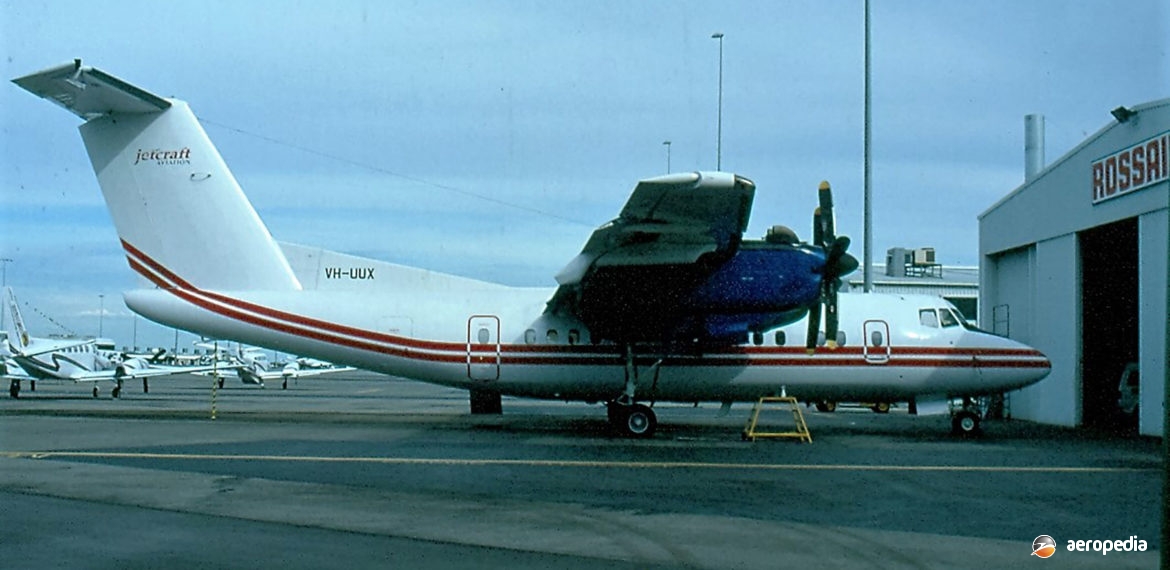Photograph:
de Havilland Canada DHC-7 Dash 7 VH-UUX (c/n 043) at Cairns, QLD in 1998 (Michael Madden)
Country of origin:
Canada
Description:
Commuter airliner
Power Plant:
(DHC-7-150)
Four 836 kw (1,120 shp) Pratt & Whitney PT6A-50 turboprops
Specifications:
- Wingspan: 28.35 m (93 ft)
- Length: 24.5 m (80 ft 4 in)
- Height: 8 m (26 ft 3 in)
- Wing area: 79.9 m² (860 sq ft)
- Max cruising speed at 2,440 m (8,000 ft): 428 km/h (266 mph)
- Economical cruising speed: 399 km/h (248 mph)
- Max operating altitude: 3,048 m (10,000 ft)
- Range with 50 passengers, IFR reserve: 1,280 km (795 miles)
- Range with max fuel and 2,949 kg (6,500 lb) payload: 2,168 km (1,347 miles)
- Service ceiling: 6,400 m (21,000 ft)
- Fuel capacity: 5,700 litres (1,254 Imp gals)
- Empty weight: 12,519 kg (27,600 lb)
- Max payload weight: 5,127 kg (11,303 lb)
- Loaded weight: 19,958 kg (44,000 lb)
History:
For many years the Canadian de Havilland Company has specialised in designing and building short take-off and landing (STOL) aircraft for a variety of uses, but mainly for the utility role. All of these designs, commencing with the DHC-2 Beaver, and including the DHC-3 Otter, DHC-4 Caribou and the DHC-5 Buffalo, have been flown in both civil and military roles, and more recently the DHC-6 Twin Otter, DHC-7 and DHC-8 have been aimed at the commuter airliner market.
Designed to operate from airfields of 610 m (2,000 ft), the Dash-7 was flown for the first time on 27 March 1975, being followed by a second pre-production aircraft on 26 June that year. Production deliveries began in mid 1977. STOL capability was obtained from the use of wide-span double-slotted trailing-edge flaps that operated within the slipstream of the propellers. In addition, there were four spoilers in the upper surface of each wing, with the inboard pair serving as spoilers or lift dumpers, and the outboard pair serving as air spoilers which operate differentially in conjunction with the ailerons to augment lateral control. New technology, slow-turning, propellers of 3.42 m (11 ft 3 in) diameter were fitted. Accommodation was provided for 50 passengers, with access being obtained by a door incorporating airstairs on the rear port side.
Development of the type continued for a period and, other than the basic Dash-7, variants included the Series 150 with a higher take-off-weight, the Series 200 with up-rated 918 kw (1,230 shp) Pratt & Whitney PT6A-55 engines, and the series 300 with accommodation increased for 60 passengers. A variant known as the Dash-7R Ranger for maritime surveillance was built for the Canadian Coast Guard. A total of 111 Dash-7s was built between 1977 and 1988.
In May 1979 a DHC-7 (C-GNBX) was demonstrated to a number of airlines in the Australasian region, and was flown on the Sydney – Lord Howe Island – Norfolk Island route, but no orders resulted. However, the type was ordered by Air Nuigini, three examples of the DHC-7-102 entering service in 1981-1982 as P2-ANN² (c/n 63 – ex C-GFCF), P2-ANO² (c/n 72 – ex C-GEWQ) and P2-ANP² (c/n 81 – ex C-GFOD) and remained in service until 1996-1998 when they were withdrawn and exported to Canada.
In 1985 Newmans Air, an airline based at Nelson, New Zealand, obtained two Dash-7s, ZK-NEW (c/n 101) and ZK-NEX (c/n 103), both being registered to Newmans Airways Ltd of Christchurch on 22 January 1985. These aircraft inaugurated the company’s services in February 1985, the company importing the aircraft to satisfy its own requirements for an expanding tourist market. In 1986 the company announced it was ordering three Dash-8s to replace the Dash-7s, which were exported overseas.
In later times a couple operated in North Queensland with Jetcraft Aviation, these being VH-UUX³ (c/n 056) registered on 11 December 1997 and VH-UUM² (c/n 043 – ex N705GW) registered on 1 December 1995, both aircraft being used for operations on resource/mining contracts. However, both were later exported, VH-UUX³ as N56HG on 28 April 1999 and VH-UUM² as N90283 on 27 June 2000.

